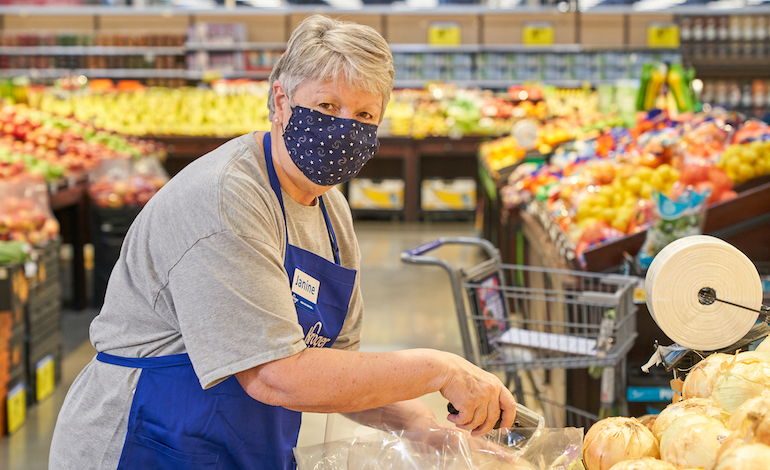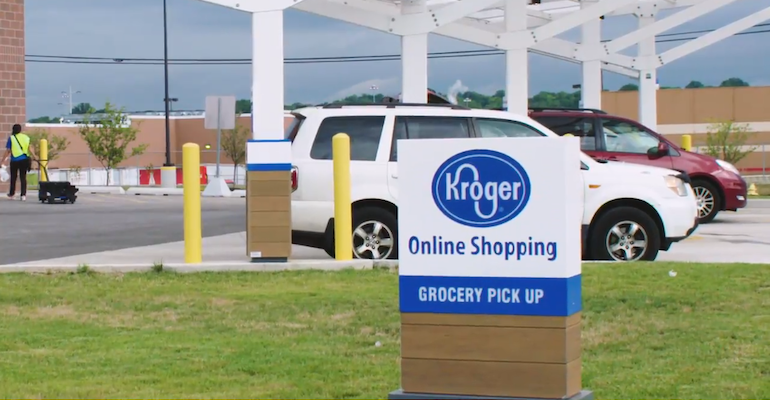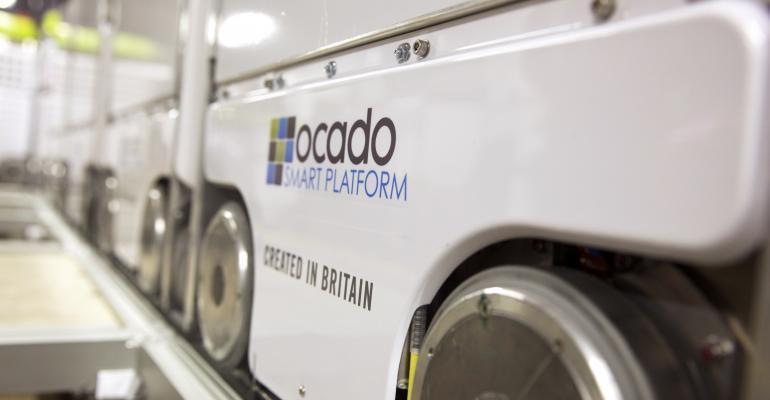By Russell Redman
Source: Supermarket News
The Kroger Co. detailed this year’s strategic growth plan — led by fresh foods and digital — at its virtual 2021 Investor Day conference.
Chairman and CEO Rodney McMullen told analysts and investors yesterday that Cincinnati-based Kroger aims to deliver a total shareholder return of 8% to 11% annually, backed by a financial model that now includes a higher operating profit base and a “clear path” to earnings growth of 3% to 5%.
In fiscal 2020, ended Jan. 30, Kroger added $10 billion to its top line. Sales totaled $132.5 billion, up 8.4% from 2019. That growth was 14.2% excluding fuel sales and dispositions. Identical sales excluding gas and adjustments surged 14.1% year over year.
“When the pandemic hit last year, our world changed dramatically. What remained constant was people’s need for food, and we were there to meet that need through new channels and formats, with a relentless focus on quality, value and convenience,” McMullen said. “We not only met our customers’ immediate needs, but we also used this unique period to accelerate our own transformation. Thanks to our team’s response and by leading with our purpose and our values, we converted the crisis into a catalysts for sustainable growth.”
‘Post-COVID era, we see three major trends shaping the industry: e-commerce, cooking at home and prepared meals to go,’ Kroger CEO Rodney McMullen said.
Kroger currently holds a 10% share of the food-at-home market, with No. 1 or No. 2 share positions in the vast majority of the major markets in which it operates, according to McMullen. The supermarket giant also has now surpassed $10 billion in e-commerce sales, which he described as a “massive shift from where we were just a few years ago.”
“Post-COVID era, we see three major trends shaping the industry: e-commerce, cooking at home and prepared meals to go. It’s true that the shift to spending more time at home and eating less at restaurants was a tailwind for our industry and that we will face tough comps as a result. But we also believe that those who are able to convert this short-term boost into long-term competitive advantages will emerge as winners. And that’s exactly what we’ve been doing,” McMullen noted.
“So how will we drive total shareholder return today and in the future? By leading with fresh food and accelerating with digital,” he said.
“First, our fresh food leadership will enable us to win share,” McMullen explained. “Second, digital is now a growth engine, and we have a clear path the digital profitability with retail media, economies of scale, and technology and process improvements that will lower our cost-to-serve. And third, with the power of the Kroger platform, we are well-positioned to compete and win in a post-COVID world. Our four competitive moats — seamless, personalization, fresh and Our Brands — are stronger today than ever before, reinforcing our confidence in our ability to grow sales and market share.”

‘Customers make decisions about where to shop based on their perception of the freshness of that retailer’s food,’ Kroger CEO Rodney McMullen noted.
A strong fresh offering is what draws shoppers to the store, whether it be brick-and-mortar or online, according to McMullen.
“We know that customers make decisions about where to shop based on their perception of the freshness of that retailer’s food. In this way, food is our core platform,” he said. “Our fresh offering is both an important sales driver for Kroger and a competitive advantage, because customers rank our fresh departments higher than those of all large national retailers.”
Kroger posted digital sales growth of 118% in fiscal 2020, with online grocery delivery service providing a sizable boost. At year-end, the retailer had 2,223 pickup sites and 2,472 delivery locations, covering 98% of the households in its market areas. Annually, 60 million households shop with Kroger either in-store or digitally. McMullen has emphasized the value of this “stickiness,” noting that Kroger sees a 98% retention rate when customers engage in both in-store and online.
“Digital is a significant growth opportunity. By digital, we mean the Kroger seamless ecosystem we’ve built over the past few years to be able to deliver anything, anytime, anywhere regardless of channel, whether pickup, delivery or shipped,” McMullen said. “Today, we are seeing more and more new customers engaging in our seamless ecosystem. Since the pandemic, we have more than doubled our digital business in 2020. We will continue to build on this momentum.”

As of the 2020 fiscal year end, Kroger had 2,223 pickup sites and 2,472 delivery locations.
What’s more, Kroger saw online customer interactions rise 30% to more than 1.3 billion across its digital properties in 2020, and the company presented nearly 11 billion personalized recommendations per week. Improved relevancy will bolster customer loyalty and reel in more sales, according to McMullen.
“Our significant reach allows us to meaningfully personalize the customer experience. At the same time, our ecosystem monetizes the traffic and data insights generated by our enhanced customer experience,” he said. “We are leveraging our assets in new ways through these fast-growing, asset-light and margin-rich businesses. This includes new businesses like our retail media business, Kroger Precision Marketing, and mature businesses like Kroger Personal Finance and our data analytics firm 84.51°. All of these contribute to incremental operating profit growth and margin.”
Kroger also touts its “Our Brands” private-label portfolio as a key differentiator for shoppers. Our Brands exceeded $26.2 billion in sales with 13.6% growth in 2020, its “best year ever,” McMullen previously reported. The five-year-old Simple Truth natural and organic brand topped $1 billion in sales with 20% growth.
“Our Brands truly provide a unique reason to shop at Kroger. Simply put, customers tell us they love Our Brands and choose them over other leading competitor brands,” McMullen told investors. “The Our Brands business, if it were a stand-alone company, would rank eighth on the Fortune 500 listing of CPGs.”
On March 3, Kroger processed its first online order through an Ocado-powered customer fulfillment center (CFC), and the first of the automated CFCs — a 335,000-square-foot facility in Monroe, Ohio — is set to become operational. Thus far, Kroger has announced locations for 10 CFCs as part of the partnership unveiled with United Kingdom-based Ocado in May 2018, which calls for 20 of the facilities to be opened in the United States.
The Ocado CFCs will be key to Kroger’s goal of doubling its digital sales and digital pass-through profitability rate by the end of 2023, Kroger Chief Information and Digital Officer Yael Cosset said in the Investor Day virtual conference.
“With the opening of our second Ocado-powered facility later this spring, we are expanding customer reach by entering entirely new geographies, with the launch of cargo delivery in Florida,” Cosset said.

Kroger’s first Ocado CFC is set to go operational soon, and its second is slated to launch in the spring. Another six are expected to open in 2022 and 2023.
Kroger also is testing a service dubbed “Hometown Pickup” to increase proximity to customers. “We launched an initiative to support first responders, creating pickup locations in local hospital parking lots to make it easier for them to get their groceries where and when it was most convenient without compromising on the expense. We saw firsthand how much of a difference that made in their lives to give them that time back,” he explained. “We are taking these learnings and capabilities we put together and making a pickup service available to new geographies and customers who do not have the immediate access to one of our stores. This pilot, which we are calling ‘Hometown Pickup,’ brings the Kroger fresh food experience to new communities, with the potential to significantly increase customer reach and convenience.”
Gabriel Arreaga, senior vice president of supply chain, said in the videoconference that the majority of Kroger Co. shoppers live within two miles of one of the company’s stores, putting 45% of the U.S. population is within reach. The launch of more Ocado CFCs will create an opportunity to serve 75% of the U.S. population within a 90-mile radius. Plans call for up to six more CFCs to open across the country in 2022 and 2023.
“We’ve invested in Ocado because it will supercharge our anything, anytime, anywhere strategy for even more growth and profitability in the future,” Arreaga said.
During the Investor Day event, Kroger reaffirmed its fiscal 2021 guidance. Given the difficult comparisons to pandemic-driven gains in 2020, the company projects identical-sales to dip 3% to 5% but show growth of 9.1% to 11.1% over a two-year stack. Operating profit in 2021 is pegged at $3.3 billion to $3.5 billion, with growth of 5.4% to 8.5% on a two-year basis.
At the bottom line, Kroger forecasts fiscal 2021 adjusted earnings per share of $2.75 to $2.95. Analysts, on average, project adjusted EPS of $2.84, with estimates ranging from $2.55 to $3.51, according to Refinitiv.
“While there remains uncertainty surrounding trends in the food-at-home market in the coming year, we are confident in our ability to navigate these unknowns,” Chief Financial Officer Gary Millerchip said, “and we’ll continue to leverage the structural tailwinds and major trends shaping our industry.”
